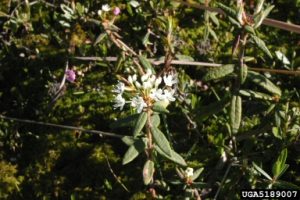Rhododendron groenlandicum
Rhododendron groenlandicum is listed as threatened in Connecticut, endangered in Ohio, and considered rare in Pennsylvania. In some regions of the country it is listed as a national wetland indicator species. Bog Labrador tea is native to the U.S. and is in the Ericaceae (Heath Family).
Photo Credit: © Paul Bolstad, University of Minnesota, Bugwood.org
Rhododendron groenlandicum
Common Name: bog Labrador tea
Other Common Names: rusty labrador-tea
Other Scientific Names: Ledum groenlandicum
Plant Functional Group: Evergreen broadleaf
Class > Order > Family: Magnoliopsida > Ericales > Ericaceae
What does the species look like?
Rhododendron groenlandicum is a multi-stemmed, perennial, evergreen shrub. It is slow growing and can reach 1 to 3 feet in height at maturity. The branches of bog Labrador tea are very hairy, and the bark is reddish-brown. Its narrow leaves are distinctive. The leaf edges roll under, and the underside is covered with a thick layer of tan fuzz. The top side of the leaf is gray-green, glossy, and aromatic. The flowers are white, grow in clusters, and are aromatic and sticky. The fruit is a brown capsule.
Bog Labrador tea can be found growing in bogs, forests, peatlands, and wet shores, and on rocky slopes. It prefers wet to moist soil and tolerates shade or sun. It also tolerates flood conditions.
Rhododendrom groenlandicum attracts bees and butterflies and is a larval host to the northern blue (Plebejus idas ) butterfly. Bog Labrador tea is said to be slightly poisonous.
Where is the species found?
States & Provinces
AB, AK, BC, CT, ID, MA, MB, ME, MI, MN, NB, ND, NH, NJ, NL, NS, NT, NU, NY, OH, ON, OR, PA, PE, QC, SD, SK, VT, WA, YT
Special Considerations for Observing
I
Which phenophases should I observe?
Do you see...?
Leaves
Breaking leaf buds More...
How many buds are breaking?
Less than 3 3 to 10 11 to 100 101 to 1,000 1,001 to 10,000 More than 10,000
Young leaves How many young leaves are present?
Less than 3 3 to 10 11 to 100 101 to 1,000 1,001 to 10,000 More than 10,000
Flowers
Flowers or flower buds More...
How many flowers and flower buds are present? For species in which individual flowers are clustered in flower heads, spikes or catkins (inflorescences), simply estimate the number of flower heads, spikes or catkins and not the number of individual flowers.
Less than 3 3 to 10 11 to 100 101 to 1,000 1,001 to 10,000 More than 10,000
Open flowers More...
What percentage of all fresh flowers (buds plus unopened plus open) on the plant are open? For species in which individual flowers are clustered in flower heads, spikes or catkins (inflorescences), estimate the percentage of all individual flowers that are open.
Less than 5% 5-24% 25-49% 50-74% 75-94% 95% or more
Fruits
Fruits Rhododendron groenlandicum , the fruit is a capsule that changes from green to brown and splits open to expose the seeds. Do not include empty capsules that have already dropped all of their seeds.More...
How many fruits are present?
Less than 3 3 to 10 11 to 100 101 to 1,000 1,001 to 10,000 More than 10,000
Ripe fruits Rhododendron groenlandicum , a fruit is considered ripe when it has turned brown and has split open to expose the seeds. Do not include empty capsules that have already dropped all of their seeds.More...
What percentage of all fruits (unripe plus ripe) on the plant are ripe?
Less than 5% 5-24% 25-49% 50-74% 75-94% 95% or more
Recent fruit or seed drop More...
How many mature fruits have dropped seeds or have completely dropped or been removed from the plant since your last visit?
Less than 3 3 to 10 11 to 100 101 to 1,000 1,001 to 10,000 More than 10,000
What do these phenophases look like?
There is currently no photoguide available for this species. If you'd like help us create one, use the guidance document and species template provided here . Then send it via email to education@usanpn.org when it is complete.
